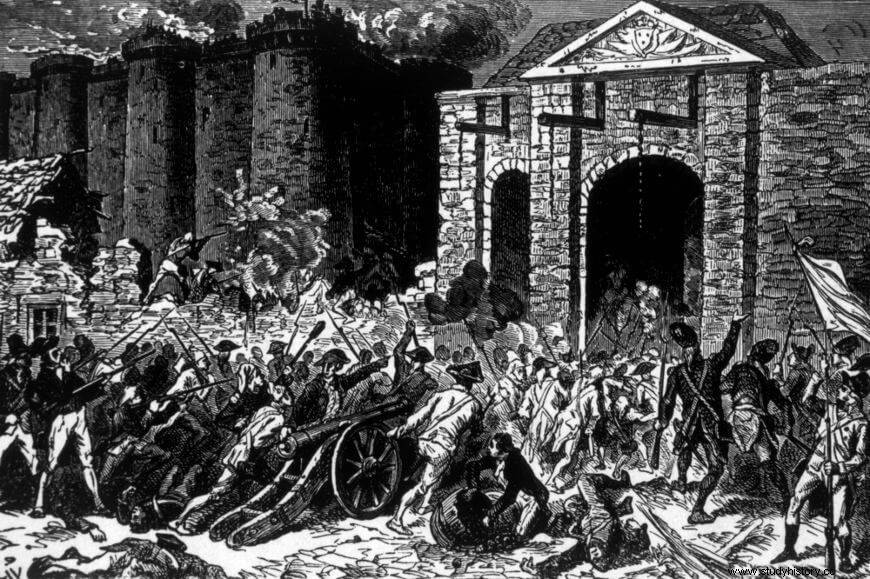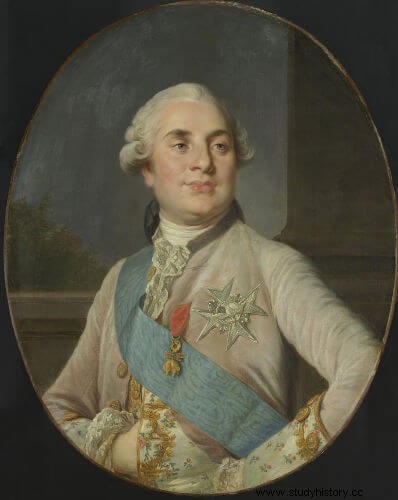
The French Revolution , as its name suggests, was a revolutionary cycle that took place in France between 1789 and 1799. Known for being one of the main revolutions in human history, the French Revolution was inspired by the Enlightenment ideals and started a process of profound transformations that resulted in the the fall of absolutism in France and the rest of Europe as well.
Also: Main events of the first bourgeois revolution in history
France before the Revolution
Historians such as Eric Hobsbawm suggest that the French Revolution was part of a process of democratic revolutions that spread across the world in the late 18th century. But, even so, it is important to pay attention to the particularities of the French situation, because, from them, we can understand what motivated the beginning of the French Revolution, in 1789|1| .
In the 1780s, France was an absolutist monarchy – one of the most powerful in Europe – and was ruled by Louis XVI , grandson of Louis XIV, the greatest absolutist king of France. Louis XVI's power was absolute, and French society was extremely stratified into social groups known as "states":
• First Status :represented by the clergy.
• Second Status :represented by the nobility.
• Third Status :represented by the rest of the population, which did not fit into the above groups.
This social division in France was marked by great inequality social , since the nobility and clergy enjoyed numerous privileges, which guaranteed them an extremely comfortable and luxurious life. Among the privileges, we can highlight the tax exemptions, which the two classes had, and, in the case of the nobility, they could even collect feudal taxes on their lands. Inequality was one of the reasons that motivated the French Revolution.

At the end of the 18th century, France was ruled by King Louis XVI.
This picture of inequality that existed in France was exacerbated with the crisis economic which settled in France during the second half of the 18th century. This economic crisis was partly a result of the king's high spending on the luxuries of the French court, but mainly because of France's involvement in two conflicts:the Seven Years' War and the American Revolution.
This economic crisis it even affected the French nobility, who, perceiving themselves in a bad economic position, began to expand their exploitation of the French people. Eric Hobsbawm presents two examples of this greater abuse:1st) the French nobility began to occupy public offices, which were previously dedicated to people of the French “middle class”; 2nd) increased feudal taxes levied on peasants|2| .
With this, we can see that, with the economic crisis in France, the nobility it affected the middle class, as it took the jobs that could be occupied by this class and it also harmed the peasants, as it increased exploitation on an extremely large portion of the French population that lived in a situation of great poverty.
The economic crisis was the second factor that motivated the French Revolution, since, as we can see, it intensified the exploitation of the peasants and made life difficult for the middle class. The situation of the peasants worsened even more with the impacts of the economic crisis, which, naturally, motivated a increase in inflation and a cost of living increase .
This increase in the cost of living became a serious problem when it affected food. In 1788 and 1789, France had bad harvests, a direct result of an extremely harsh winter that hit the country during this period. With bad harvests, the price of food increased, and many peasants could not afford it. Result:hunger increased .
Still on the economic crisis, it is important to mention that it was motivated by excessive spending of the French government. Eric Hobsbawm says that France spent 20% more than it collected in that period|3| . To make matters worse, attempts to reform France's financial and tax system were suggested, but failed to thrive, because nobility and clergy were unwilling to give up their privileges.
The solution found, to discuss possibilities to overcome the crisis in France, was to convene the Assembly of the Estates General .
Also see: Learn about one of the most symbolic constructions of French absolutism
States General Crisis
The Estates General was an assembly convened in times of emergency that had its origins in the Middle Ages. The last time such a meeting had taken place in France was in the year 1614. The strategy of the nobility and clergy with this assembly was to take a measure that did not harm their interests.
The Assembly of the Estates General worked as follows:it was composed of more than 1000 deputies, who proportionally represented each of the States that existed in France. Decisions were taken by means of a vote per state, that is, each state had the right to one vote, adding up to a total of three votes.
During the Assembly of the Estates General, the Third Estate was dissatisfied with the system and proposed its amendment. Representatives of the Third Estate proposed that the vote should be individual, and this was extremely interesting for them, as it increased the chances that they would obtain a decision that favored them in the States General.
Faced with this situation, the French king tried to dissolve the Assembly of the Estates General. The representatives of the Third Estate did not accept the situation, rebelled and founded the National Constituent Assembly with the aim of writing a constitution to transform France into a constitutional monarchy.
Coincidentally, the action of the Third Estate took place at a time of great popular uprising, due to the strong crisis that affected France and harmed the poor populations of Paris. Thus, when the Assembly of the Estates General took place, Paris was on the verge of popular uprising, and the people of Paris fully supported the actions of the Third Estate.
The king tried to shut down the National Constituent Assembly, and the popular reaction was to take to the streets of Paris and defend the institution that had been created by the Third Estate. Soon, the representatives of the Third Estate created the Commune , a provisional government of Paris, and ordered the creation of the Guard National , a militia composed of the people.
Bastillefall
The Parisian population took to the streets of the city on July 12, 1789. Popular agitation remained and, on July 14, the population continued with its uprising, attacking first Arsenal of the Invalides and then promoting the fall of the Bastille . The Bastille was an old fortress that had been turned into a prison for political opponents of the French kings.
At the time of the attack, the Bastille was practically empty and held only seven prisoners. The people of Paris who had rebelled wanted to take the gunpowder that was stored in the Bastille, which was the symbol of the oppression of the Ancien Régime, that is, of French absolutism.
With the news of the fall of the Bastille, the revolution spread throughout France, precipitating transformations in the country and leading thousands of people, in cities and countryside, to rebel against French aristocracy and against the Ancien Régime.
|1| HOBSBAWM, Eric. The Age of Revolutions 1789-1848. Rio de Janeiro:Peace and Earth, 2014, p. 98-99.
|2| Ditto, p. 103.
|3| Ditto, p. 205.
